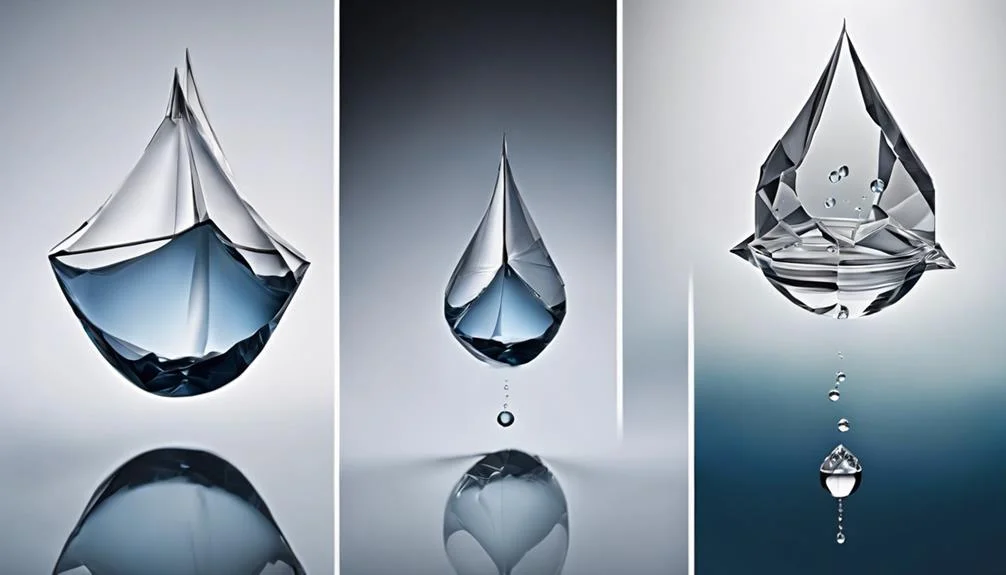The efficacy and environmental friendliness of hydrogen peroxide water treatment make it an appealing choice for many, offering a potent solution for oxidizing contaminants without leaving harmful residues. This method, lauded for its simplicity and the benign nature of its byproducts, raises important considerations on both sides of the spectrum.
While the advantages are clear, the method is not without its challenges, including cost and specific water quality issues that may not be fully addressed by hydrogen peroxide alone. A nuanced discussion on these aspects can provide valuable insights for those contemplating the adoption of this treatment system.
Key Takeaways
- Hydrogen peroxide is a powerful and eco-friendly water treatment option, breaking down into harmless substances.
- Offers improved water quality by efficiently removing contaminants and enhancing taste.
- While initial costs are higher than chlorine treatments, long-term maintenance and environmental benefits can offset expenses.
- Requires careful dosing and regular system checks to mitigate risks of corrosion and ensure optimal performance.
Effective Disinfection
Hydrogen peroxide stands out as a powerful oxidizing agent, offering swift and effective disinfection of water by neutralizing a wide array of contaminants without leaving harmful by-products. Its rapid action surpasses traditional methods like chlorine, facilitating quicker and more efficient water disinfection processes. This characteristic is particularly beneficial in scenarios where time is of the essence, ensuring that water becomes safe for use in a shorter period.
Moreover, unlike chlorine, hydrogen peroxide does not produce disinfection by-products (DBPs), which are often associated with various health risks. This aspect makes it a safer alternative, ensuring that the treated water remains free from potentially harmful substances. The effectiveness of hydrogen peroxide in eliminating common well water contaminants such as iron and sulfur further underscores its utility. These elements, which can cause significant water quality issues, are efficiently addressed through hydrogen peroxide treatment.
Furthermore, the cost-effectiveness of hydrogen peroxide water treatment presents a viable solution for many, striking a balance between efficiency and affordability. This treatment method not only ensures the disinfection of water but does so without compromising the water quality, making it a reliable choice for ensuring safe water.
Eco-Friendly Solution

Turning our attention to the environmental benefits, the use of hydrogen peroxide as a water treatment solution presents a significant advantage in terms of reducing chemical usage and lowering the carbon footprint.
By breaking down into harmless substances, oxygen and water, it ensures that water bodies are not subjected to toxic residues or chemical pollutants.
This characteristic not only underscores its sustainability but also highlights its role in promoting eco-conscious water management practices.
Reduces Chemical Usage
In an era of heightened environmental awareness, the adoption of hydrogen peroxide water treatment emerges as a promising eco-friendly solution, significantly reducing the reliance on harsh chemicals. This method not only champions a greener approach but also ensures a safer water supply by minimizing harmful by-products. Here's how it benefits the environment:
- Minimizes Chemical Usage: Directly reduces the need for traditional, more harmful water treatment chemicals.
- Promotes Cleaner Water: Reduces the introduction of chemical by-products, ensuring a safer water supply.
- No Residual Chemicals: Breaks down into harmless oxygen and water, leaving no harmful residues.
- Environmental Impact: Offers a more sustainable alternative to traditional methods, lessening the ecological footprint of water treatment processes.
Lowers Carbon Footprint
Why is lowering our carbon footprint crucial in contemporary water treatment methods?
The introduction of hydrogen peroxide as a water treatment solution offers a compelling answer. This method significantly reduces the carbon footprint by breaking down into oxygen and water, leaving no harmful byproducts in its wake. It stands as an eco-friendly alternative that eschews the introduction of chemical residuals or toxins into the environment.
By adopting hydrogen peroxide for water purification, we contribute to a cleaner, healthier ecosystem. This approach not only combats water contaminants effectively but also aligns with green practices, promoting a sustainable and environmentally safe choice for water treatment.
As such, hydrogen peroxide water treatment embodies a forward-thinking solution in our collective quest for eco-conscious water purification methods.
No Residual Taste

Turning our attention to the quality of water post-treatment, a notable advantage of hydrogen peroxide water treatment is its ability to enhance water flavor by leaving no residual taste. Unlike chlorine-based treatments, which can impart an unpleasant flavor and odor, hydrogen peroxide ensures that water retains a clean and fresh taste, devoid of any chemical aftertaste.
This attribute not only improves the drinking experience but also benefits culinary applications, where the purity of water is paramount.
Enhances Water Flavor
One notable benefit of hydrogen peroxide water treatment is its ability to enhance water flavor by effectively eliminating any residual taste. This characteristic sets it apart from chlorine treatments, which can leave a noticeable aftertaste. By removing these unwelcome flavors, hydrogen peroxide treatment makes water more palatable and enjoyable to drink.
- Eliminates Residual Taste: Unlike chlorine treatments, hydrogen peroxide does not leave behind any unwanted taste in the water.
- Improves Palatability: The absence of residual taste makes the water more enjoyable to drink for everyone.
- Fresher Taste: Users often report that water treated with hydrogen peroxide tastes cleaner and fresher.
- Beneficial for Sensitive Individuals: People sensitive to flavors in their drinking water find hydrogen peroxide treatment significantly advantageous.
No Chemical Aftertaste
A significant advantage of hydrogen peroxide water treatment is its capacity to ensure the water remains free from any chemical aftertaste, preserving its natural flavor profile. Unlike traditional methods, such as chlorination, which often impart a noticeable and sometimes unpleasant taste to the water, hydrogen peroxide stands out for its ability to treat water without leaving any residual taste.
This key feature significantly enhances the overall drinking experience, allowing individuals to enjoy clean, fresh-tasting water. The absence of any unwanted flavors or chemical residues means that water treated with hydrogen peroxide maintains its natural taste, ensuring that the purity and quality of the water are uncompromised. This makes hydrogen peroxide an attractive option for those seeking a water treatment solution that does not affect water's inherent taste.
Risk of By-Products

Hydrogen peroxide water treatment significantly reduces the risk of harmful by-products, offering a safer alternative to traditional chlorine-based disinfection methods. Unlike chlorine treatment, which can lead to the formation of disinfection by-products (DBPs) harmful to human health and the environment, hydrogen peroxide offers a cleaner, more sustainable solution. By minimizing the creation of these by-products, hydrogen peroxide ensures the provision of healthier and safer water.
To paint a clearer picture, consider the following aspects:
- No Formation of DBPs: Hydrogen peroxide treatment does not form disinfection by-products, a common issue with chlorine-based treatments, making it a safer choice for water disinfection.
- Minimized Health Risks: The potential health risks associated with disinfection by-products are significantly reduced, ensuring the water is safe for consumption and other uses.
- Environmental Friendliness: By eliminating the concern of chemical by-products, hydrogen peroxide promotes a more environmentally friendly water disinfection method.
- Sustainable Water Purification: Opting for hydrogen peroxide treatment helps avoid the formation of harmful by-products, ensuring safer and more sustainable water purification practices.
Through these considerations, it becomes evident that hydrogen peroxide water treatment presents a compelling case for those concerned about the quality and safety of their water.
Precise Dosing Required

While hydrogen peroxide water treatment offers numerous benefits, achieving these advantages necessitates precise dosing to ensure the effective removal of contaminants. The efficacy of this treatment method hinges on the accurate application of hydrogen peroxide, which plays a pivotal role in oxidizing substances like iron and sulfur that can compromise water quality. Proper dosing is not a mere recommendation but a requisite for the optimal performance of the treatment process. It ensures that the chemical reaction necessary to degrade pollutants occurs efficiently, leading to the desired purity and safety of the water.
However, the challenge of dosing precision cannot be understated. Overdosing hydrogen peroxide can counterintuitively lead to ineffective treatment, introducing potential negative impacts on the water's quality and safety. On the other hand, underdosing might result in inadequate oxidation, leaving contaminants partially removed and thus compromising the treatment's goal of achieving clean water. This delicate balance underscores the importance of meticulous control in the dosing process. Precision in administering hydrogen peroxide is essential, not just for the success of the water treatment but also for maintaining the integrity and quality of the water being treated.
Potential Corrosion Issues

Despite its effectiveness in purifying water, hydrogen peroxide treatment can pose corrosion risks to metal pipes and fixtures due to its strong oxidative properties. The interaction of hydrogen peroxide with certain metals, especially those commonly found in plumbing systems like iron and copper, can accelerate the corrosion process. This not only compromises the integrity of the water treatment infrastructure but also raises concerns about the long-term sustainability and safety of these systems.
To understand these risks better, consider the following points:
- Corrosion and Leak Potential: Continuous exposure to hydrogen peroxide can lead to the gradual degradation of metal pipes and fixtures, increasing the likelihood of leaks and significant water damage over time.
- Metal Specificity: Certain metals, particularly iron and copper, are more susceptible to the corrosive effects of hydrogen peroxide, necessitating more vigilant monitoring and maintenance in systems employing these materials.
- Maintenance Requirements: Regular checks are crucial for detecting early signs of corrosion, thereby preventing extensive damage and ensuring the longevity and efficiency of the water treatment system.
- Mitigation Strategies: Implementing the use of corrosion-resistant materials or protective coatings can significantly reduce the risk of hydrogen peroxide-induced corrosion, safeguarding the infrastructure from potential damage.
Cost Considerations

Evaluating the economic aspects of hydrogen peroxide water treatment reveals that annual expenses can range from $200 to $600, contingent upon various factors including system size and water quality. This variance in cost underscores the importance of conducting a detailed water analysis prior to system implementation. Such analysis is essential not only for determining the system's effectiveness in addressing specific contaminants like iron and sulfur but also for achieving a cost-effective treatment solution.
Although hydrogen peroxide is more expensive than traditional chlorine treatments, its efficacy in removing certain contaminants justifies the initial cost for many users. Moreover, the maintenance expenses associated with hydrogen peroxide systems are generally lower than those for other water treatment methods. This is partly because these systems, when properly installed and maintained, tend to have fewer mechanical issues and require less frequent service interventions.
The key to optimizing both cost-effectiveness and performance of hydrogen peroxide water treatment lies in thorough upfront analysis and ongoing, diligent system maintenance. By acknowledging these cost considerations and acting accordingly, users can ensure that their investment in hydrogen peroxide treatment provides both effective water purification and long-term economic benefits.
Conclusion
In conclusion, hydrogen peroxide water treatment presents a viable disinfection method, offering significant benefits such as:
- Effective elimination of contaminants
- An environmentally friendly breakdown process
- The absence of residual taste in treated water
However, the technique is not without challenges, including:
- The risk of by-product formation
- The necessity for precise dosing
- Potential corrosion issues
- Higher costs compared to alternative treatments
These factors necessitate a thorough evaluation to determine its suitability for specific water treatment needs, ensuring an optimal balance between efficacy and practicality.










